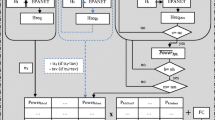Abstract
Nowadays, some of the existing irrigation distribution networks (IDNs) are facing hydraulic performance problems, due partly to the ageing of pipe networks, initial design flaws, improper management or/and the increase in water demand. Rehabilitation of these networks may become an inevitable need to provide the best services to farmers. To this end, a comprehensive computer model was developed to assist planners and decision makers in the determination of the most cost-effective strategy for the rehabilitation of irrigation networks. This model incorporates an innovative algorithm for the automatic search of the best looping positions in the network. Two multi-objective optimizations were applied for the rehabilitation of a real medium-size network operating on-demand and by gravity, one included the looping option while the other excluded this option. The two Pareto fronts, associated with each optimization, clearly indicated that it is imperative to consider the localized loops option during the rehabilitation process as it provided superior cost-effective solutions. The comparison between two selected cases from each front showed that even though the two solutions offered the same magnitude of improvement to the network, a cost saving of about 77% is obtained by choosing the case with the looping option. The model developed in the framework of this work represents a powerful optimization tool for cost-effective rehabilitation of irrigation networks.








Similar content being viewed by others
References
Aliod R, González C (2008) A computer model for pipe flow irrigation problems. In: Garcia-Navarro P, Playán E (eds) Numerical modelling of hydrodynamics for water resources. Proceedings of the Conference on Numerical Modelling of Hydrodynamic Systems, Zaragoza, Spain, 18-21 June, vol 2007. Taylor & Francis, London, pp 293–313
Artina S, Bragalli C, Erbacci G, Marchi A, Rivi M (2012) Contribution of parallel NSGA-II in optimal design of water distribution networks. J Hydroinf 14:310–323. https://doi.org/10.2166/hydro.2011.014
Deb K, Pratap A, Agarwal S, Meyarivan T (2002) A fast and elitist multiobjective genetic algorithm: NSGA-II. IEEE Trans Evol Comput 6:182–197. https://doi.org/10.1109/4235.996017
Farmani R, Walters G, Savic D (2006) Evolutionary multi-objective optimization of the design and operation of water distribution network: total cost vs. reliability vs. water quality. J Hydroinf 8:165–179. https://doi.org/10.2166/hydro.2006.019
Farmani R, Abadia R, Savic D (2007) Optimum design and management of pressurized branched irrigation networks. J Irrig Drain Eng 133:528–537. https://doi.org/10.1061/(ASCE)0733-9437(2007)133:6(528)
Fernández García I, Creaco E, Rodríguez Díaz JA, Montesinos P, Camacho Poyato E, Savic D (2016) Rehabilitating pressurized irrigation networks for an increased energy efficiency. Agric Water Manage 164(Part 2):212–222. https://doi.org/10.1016/j.agwat.2015.10.032
Fouial A, Khadra R, Daccache A, Lamaddalena N (2016) Modelling the impact of climate change on pressurised irrigation distribution systems: Use of a new tool for adaptation strategy implementation. Biosyst Eng 150:182–190. https://doi.org/10.1016/j.biosystemseng.2016.08.010
Giustolisi O, Berardi L (2009) Prioritizing pipe replacement: From multiobjective genetic algorithms to operational decision support. J Water Resour Plan Manag 135:484–492. https://doi.org/10.1061/(ASCE)0733-9496(2009)135:6(484)
Goldberg DE (1989) Genetic algorithms in search, optimization and machine learning. Addison-Wesley Longman Publishing Co., Inc., USA
Lamaddalena N (1997) Integrated simulation modeling for design and performance analysis of on-demand pressurized irrigation systems. Universidade Técnica de Lisboa, PhD thesis
Lamaddalena N, Sagardoy JA (2000) Performance analysis of on-demand pressurized irrigation systems. FAO Irrigation and Drainage Paper 59. FAO Irrigation and Drainage Paper 59. Food and Agriculture Organization of the United Nations, Rome, Italy
Lamaddalena N, Khadra R, Fouial A (2015) Use of localized loops for the rehabilitation of on-demand pressurized irrigation distribution systems. Irrig Sci 33:453–468. https://doi.org/10.1007/s00271-015-0481-5
Murphy LJ, Dandy GC, Simpson AR, Gransbury JC (1998) Optimisation of irrigation infrastructure rehabilitation using genetic algorithms. Paper presented at the National Conference. Irrigation Association of Australia, Brisbane, Australia, May
Nicolini M (2004) Evaluating performance of multi-objective genetic algorithms for water distribution system optimization. In: Sixth International Conference on Hydroinformatics. World Scientific Publishing Company, pp 850–857
Olsson RJ, Kapelan Z, Savic DA (2009) Probabilistic building block identification for the optimal design and rehabilitation of water distribution systems. J Hydroinf 11:89–105. https://doi.org/10.2166/hydro.2009.047
Reca J, Martínez J (2006) Genetic algorithms for the design of looped irrigation water distribution networks. Water Resour Res 42:W05416. https://doi.org/10.1029/2005WR004383
Roshani E, Filion YR (2014) Water distribution system rehabilitation under climate change mitigation scenarios in Canada. J Water Resour Plan Manag 141:04014066. https://doi.org/10.1061/(ASCE)WR.1943-5452.0000450
Rossman LA (2000) EPANET 2 users manual. National Risk Management Research Laboratory. U.S. Environmental Protection Agency, Cincinnati, USA
Saleh SA, Tanyimboh T (2013) Coupled Topology and Pipe Size Optimization of Water Distribution Systems. Water Resour Manag 27:4795–4814. https://doi.org/10.1007/s11269-013-0439-4
Tanyimboh TT, Seyoum AG (2016) Multiobjective evolutionary optimization of water distribution systems: Exploiting diversity with infeasible solutions. J Environ Manag 183(Part 1):133–141. https://doi.org/10.1016/j.jenvman.2016.08.048
Wang Q, Creaco E, Franchini M, Savić D, Kapelan Z (2015) Comparing low and high-level hybrid algorithms on the two-objective optimal design of water distribution systems. Water Resour Manag 29:1–16. https://doi.org/10.1007/s11269-014-0823-8
White T, He S (2012) An empirical comparison of several recent multi-objective evolutionary algorithms. In: Iliadis L, Maglogiannis I, Papadopoulos H (eds) Artificial Intelligence Applications and Innovations: 8th IFIP WG 12.5 International Conference, AIAI 2012, Halkidiki, Greece, September 27–30, 2012, Proceedings, Part I. Springer Berlin Heidelberg, Berlin, Heidelberg, pp 48–57. https://doi.org/10.1007/978-3-642-33409-2_6
Wu W, Maier HR, Simpson AR (2013) Multiobjective optimization of water distribution systems accounting for economic cost, hydraulic reliability, and greenhouse gas emissions. Water Resour Res 49:1211–1225. https://doi.org/10.1002/wrcr.20120
Zitzler E, Deb K, Thiele L (2000) Comparison of multiobjective evolutionary algorithms: Empirical results. Evol Comput 8:173–195. https://doi.org/10.1162/106365600568202
Author information
Authors and Affiliations
Corresponding author
Rights and permissions
About this article
Cite this article
Fouial, A., García, I.F., Bragalli, C. et al. Multi-Objective Optimization Model Based on Localized Loops for the Rehabilitation of Gravity-fed Pressurized Irrigation Networks. Water Resour Manage 32, 465–480 (2018). https://doi.org/10.1007/s11269-017-1821-4
Received:
Accepted:
Published:
Issue Date:
DOI: https://doi.org/10.1007/s11269-017-1821-4




